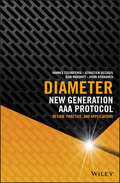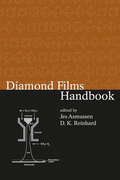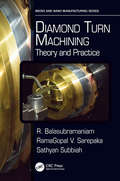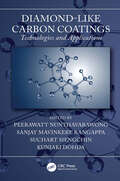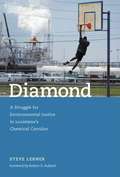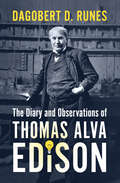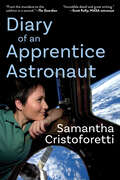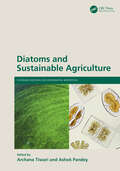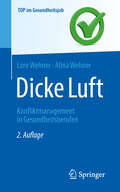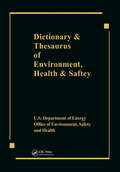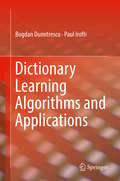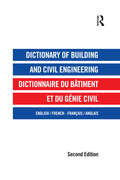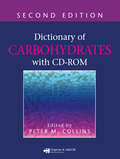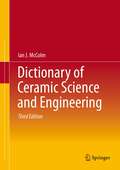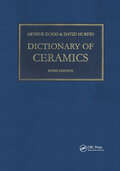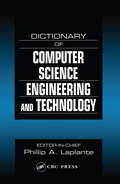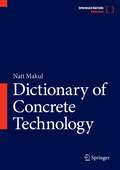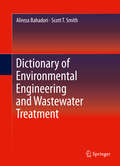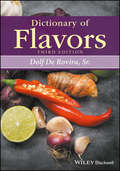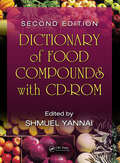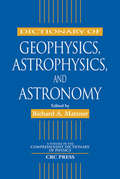- Table View
- List View
Diameter: New Generation AAA Protocol - Design, Practice, and Applications
by Jouni Korhonen Hannes Tschofenig Sébastien Decugis Jean MahoneyPresents the principles, design, development and applications of the Diameter protocol suite The Diameter protocol was born in the Internet Engineering Task Force (IETF) and designed to be a general-purpose Authentication, Authorization, and Accounting (AAA) protocol applicable to many network environments. This book is for everyone who wants to understand the Diameter protocol and its applications. This book explains the place Diameter holds in global telecommunication networks and teaches system architects and designers how to incorporate Diameter into their network environments. Diameter: New Generation AAA Protocol - Design, Practice and Applications begins by describing the foundation of Diameter step-by-step, starting with building blocks of the protocol, and progressing from a simple two-party exchange to a multi-party exchange involving complex routing. It discusses the motivation for using Diameter, talks about its predecessor, RADIUS, and introduces the open source Diameter implementation, freeDiameter. The book expands beyond protocol basics to cover end-to-end communication, security functionality, and real-world applications, extending to the backend infrastructure of mobile telecommunications. In addition, an advanced chapter teaches readers how to develop Diameter extensions for their own AAA applications. Written by an experienced author team who are members of the group that standardized Diameter in the IETF and are at the forefront of this cutting-edge technology Presents the still-developing topic of Diameter from both introductory and advanced levels Makes available for download a virtual machine containing the open source implementation: https://diameter-book.info Provides hands-on experience via freeDiameter examples and exercises throughout the book Diameter: New Generation AAA Protocol - Design, Practice and Applications will appeal to system architects and system designers, programmers, standardization experts new to Diameter, students and researchers interested in technology that is deployed by many network operators.
Diamond Films Handbook
by Jes Asmussen D. K. ReinhardThe Diamond Films Handbook is an important source of information for readers involved in the new diamond film technology, emphasizing synthesis technologies and diamond film applications. Containing over 1600 references, drawings, photographs, micrographs, equations, and tables, and contributions by experts from both industry and academia, it inclu
Diamond Turn Machining: Theory and Practice (Micro and Nanomanufacturing Series)
by R. Balasubramaniam RamaGopal V. Sarepaka Sathyan SubbiahThe goal of this book is to familiarize professionals, researchers, and students with the basics of the Diamond Turn Machining Technology and the various issues involved. The book provides a comprehensive knowledge about various aspects of the technology including the background, components of the machine, mechanism of material removal, application areas, relevant metrology, and advances taking place in this domain. Solved and unsolved examples are provided in each of the areas which will help the readers to practice and get familiarized with that particular area of the Diamond Turn Machining process.
Diamond and Related Nanostructures
by Csaba Levente Nagy Mircea Vasile DiudeaOver the past twenty years, the field of carbon structures has been invigorated by the discovery of fullerenes and carbon nanotubes. These nano-structured carbons have attracted a tremendous interest in the fundamental properties of discrete carbon molecules, leading to the discovery of novel complex crystalline and quasi-crystalline materials. As a consequence, a variety of applications have been developed, including technical and bio-medical materials and miniaturized tools. Diamond and Related Nanostructures focuses on the advances in the area of diamond-like carbon nanostructures (hyper-structures built from fullerenes and/or carbon nanotube junctions) and other related carbon nanostructures. Each chapter contributes to the topic from different fields, ranging from theory to synthesis and properties investigation of these new materials. This volume brings together the major findings in the field and provides a source of inspiration and understanding to advanced undergraduates, graduates, and researchers in the fields of Physics, Graph Theory, Crystallography, Computational and Synthetic Chemistry.
Diamond-Like Carbon Coatings: Technologies and Applications
by Suchart Siengchin Sanjay Mavinkere Rangappa Peerawatt Nunthavarawong Kuniaki DohdaDiamond-like carbons (DLCs) display a number of attractive properties that make them versatile coating materials for a variety of applications, including extremely high hardness values, very low friction properties, very low gas permeability, good biocompatibility, and very high electrical resistivity, among others. Further research into this material is required to produce hydrogen-free DLC films and to synthesize it together with other materials, thereby obtaining better film properties. Diamond-Like Carbon Coatings: Technologies and Applications examines emerging manufacturing technologies for DLCs with the aim of improving their properties for use in practical applications. Discusses DLC coatings used in mechanical, manufacturing, and medical applications Details recent developments in the novel synthesis of DLC films Covers advances in understanding of chemical, structural, physical, mechanical, and tribological properties for modern material processing Highlights methods to yield longer service life Considers prospects for future applications of emerging DLC technologies This work is aimed at materials science and engineering researchers, advanced students, and industry professionals.
Diamond: A Struggle for Environmental Justice in Louisiana's Chemical Corridor
by Robert D. Bullard Steve LernerFor years, the residents of Diamond, Louisiana, lived with an inescapable acrid, metallic smell -- the "toxic bouquet" of pollution -- and a mysterious chemical fog that seeped into their houses. They looked out on the massive Norco Industrial Complex: a maze of pipelines, stacks topped by flares burning off excess gas, and huge oil tankers moving up the Mississippi. They experienced headaches, stinging eyes, allergies, asthma, and other respiratory problems, skin disorders, and cancers that they were convinced were caused by their proximity to heavy industry. Periodic industrial explosions damaged their houses and killed some of their neighbors. Their small, African-American, mixed-income neighborhood was sandwiched between two giant Shell Oil plants in Louisiana's notorious Chemical Corridor. When the residents of Diamond demanded that Shell relocate them, their chances of success seemed slim: a community with little political clout was taking on the second-largest oil company in the world. And yet, after effective grassroots organizing, unremitting fenceline protests, seemingly endless negotiations with Shell officials, and intense media coverage, the people of Diamond finally got what they wanted: money from Shell to help them relocate out of harm's way. In this book, Steve Lerner tells their story. Around the United States, struggles for environmental justice such as the one in Diamond are the new front lines of both the civil rights and the environmental movements, and Diamond is in many ways a classic environmental-justice story: a minority neighborhood, faced with a polluting industry in its midst, fights back. But Diamond is also the history of a black community that goes back to the days of slavery. In 1811, Diamond (then the Trepagnier Plantation) was the center of the largest slave rebellion in United States history. Descendants of these slaves were among the participants in the modern-day Diamond relocation campaign. Steve Lerner talks to the people of Diamond, and lets them tell their story in their own words. He talks also to the residents of a nearby white neighborhood -- many of whom work for Shell and have fewer complaints about the plants -- and to environmental activists and Shell officials. His account of Diamond's 30-year ordeal puts a human face on the struggle for environmental justice in the United States.
Diamonds of Doom (Escape from Planet Alcatraz)
by Michael DahlTraveling by night, Zak Nine and Erro are following a shadowy figure until the mysterious stranger disappears into a cave. The boys decide to follow. Inside they find a maze filled with priceless gems, along with a rough band of escaped criminals. Things go from bad to worse when a squad of Alcatraz guards arrives on the scene. When the guards start shooting their laser blasters, suddenly nobody is safe! Will Zak and Erro escape the deadly storm of laser fire, or will they be trapped in the endless dark forever?
Diary and Observations of Thomas Alva Edison
by Dagobert D. RunesGain insight into the unique thinking and philosophy of the world&’s most prolific inventor with this collection of his writings.American scientist and businessman Thomas Edison contributed much to the well-being and comfort of our modern life. He gave us the electric light, the phonograph, and the motion-picture camera, along with more than one thousand other inventions. Edison was, as fellow inventor Guglielmo Marconi put it, &“one of the world&’s greatest benefactors.&” In this volume, editor Dagobert D. Runes presents Edison&’s diary along with a selection of his social and philosophical ideas taken from available notes, statements, and observations. Readers will discover that many of Edison&’s casual remarks made decades ago have a definite contemporary significance. His propositions in ethics, philosophy, music, and education show a rare combination of whimsy and deep sincerity.
Diary of an Apprentice Astronaut
by Samantha CristoforettiAstronaut Samantha Cristoforetti’s intimate account of her first journey to the International Space Station, to which she returns in 2022, as commander of Expedition 68a—only the fourth woman to command the ISS, praised by Scott Kelly for its “incredible detail and great writing.” Two hundred days orbiting Earth on the International Space Station. Five years working and training with the aerospace community across the world. A lifetime of choices leading to the stars. These are the components of Samantha Cristoforetti’s dream, a dream she invites us to share in this intimate account of an astronaut’s journey to space. She views the triumphs and disappointments of that journey with a poet’s eye and a philosopher’s mind—and an engineer’s gift for detail that brings each experience into sharp focus. With Cristoforetti as our guide, we’re called to become “apprentice astronauts” and experience the world anew through the visor of a space suit’s helmet. Bonding with crew members to tackle challenges as a team, lifting off from the launchpad in a roar of engines, discovering the strange wonders of weightlessness, seeing Earth with a fresh perspective after a bittersweet return to solid ground . . . all these moments and more reveal what it really takes to escape our planet’s gravity in pursuit of a goal.
Diatoms and Sustainable Agriculture (Sustainable Industrial and Environmental Bioprocesses)
by Archana TiwariThis book highlights the multifaceted role of diatoms in revolutionizing agricultural practices toward sustainability. The introductory chapter of Diatoms and Sustainable Agriculture examines the fundamental role of diatoms in fostering a circular economy within the agricultural sector, discussing the challenges and prospects associated with integrating diatoms into sustainable agricultural practices. Additionally, it reviews the potential of diatoms as natural plant growth promoters, elucidating the mechanisms through which these microorganisms enhance crop productivity while reducing reliance on synthetic fertilizers and pesticides. The chapter also covers the pivotal role of diatoms in agricultural watersheds, serving as indicators of ecosystem health and guiding strategies for maintaining river integrity. Furthermore, the book introduces the potential of diatoms for agricultural wastewater bioremediation and applications of diatom frustules as biosensors for the early detection of plant pathogens. The subsequent chapters explore the current status and future prospects of diatoms as insect control agents, highlighting their potential as environmentally friendly alternatives to conventional pesticides. Toward the end, the text delves into the intersection of artificial intelligence and diatom microalgae-based agriculture. This book serves as an important source for researchers and academicians in phycology, biotechnology, and agricultural sciences.
Dicas Profissionais Para Linha De Comando Bash
by Jason Cannon Rafaella C. S. BarrosSe você já disse para si mesmo: "Tem que ter uma maneira melhor de fazer isso", então continue lendo.Como alguém que tem usado a Bash shell quase diariamente por 15 anos, acumulei vários "truques" de linha de comando que me economizaram tempo e frustrações. Dicas Profissionais para Linha de Comando Bash é uma coleção de 10 técnicas que você pode começar a usar imediatamente para aumentar sua eficiência com linha de comando.Eis o que você vai aprender lendo Dicas Profissionais para Linha de Comando Bash:Dica 1: Completar com TabDica 2: Alterar para o diretório anteriorDica 3: Reutilizar o último item da linha de comando anteriorDica 4: Executar novamente um comando que inicia com uma string fornecidaDica 5: Substituição de comandoDica 6: Usar um laço de repetição em "for" na linha de comandoDica 7: Re-executar o comando anterior com privilégios de administradorDica 8: Re-executar o comando anterior enquanto substitui uma stringDica 9: Reutilizar uma palavra na mesma linha de comandoDica 10: Corrigindo erros de digitação e encurtando comandos longos com apelidos
Dicke Luft - Konfliktmanagement in Gesundheitsberufen (Top im Gesundheitsjob)
by Lore Wehner Alina WehnerAngehörige von Gesundheitsberufen sind durch ständige Veränderungsprozesse, Personalmangel, komplexe Dokumentationspflichten sowie den hohen Qualitätsmaßstäben und Haftungsrisiken einem steigenden Erwartungsdruck ausgesetzt. So sind vermehrt Konflikte durch Überforderung, Leistungsdruck, gesetzlichen und innerbetrieblichen Vorgaben zu beobachten. Die Konfliktebenen sind vielfältig und reichen von der Führung, über das Team und andere Berufsgruppen bis hin zum Patienten, Kunden und den Angehörigen. Besonders im Berufsalltag wirken sich ungelöste Konflikte und schwelende Konfliktpotenziale nicht nur auf das Wohlbefinden des Einzelnen aus, sondern werden rasch zum Kostenfaktor für das gesamte Unternehmen. Häufige Krankenstände, verminderte Leistungsfähigkeit, Mobbing, Burnout, hohe Personalfluktuation und Imageverlust sind nur einige Folgeerscheinungen. Die erfahrene Autorin stellt in diesem Buch speziell auf den Gesundheits- und Krankenpflegebereich abgestimmte Methoden zur Konfliktbearbeitung und -prävention vor. Fallbeispiele und Erfahrungsberichte geben Einblick in die Praxis. Der Leser erfährt Möglichkeiten, Chancen und Grenzen gewaltfreier, nonverbaler und interkultureller Kommunikation und Konfliktlösungsstrategien. Verschiedene Lösungsansätze wie z.B. Einzelgespräch, Teamgespräch und Mediation werden vorgestellt und die Vor- und Nachteile erläutert. Das neuartige Konfliktlotsenmodell gibt einen Ausblick wie zukünftig Konflikte kreativ bewältigt werden können..
Dictionary & Thesaurus of Environment, Health & Safety
by US Dept of EnergyDictionary & Thesaurus of Environment, Health & Safety is the first and only dictionary/thesaurus to focus on the usage and structure of environment, health, and safety terminology. Containing nearly 600 pages, this book features thousands of terms that may be hard to find in any other reference source. Thesaurus terms are presented under broad subject categories, and all acronyms found in the thesaurus are listed with their reciprocal phrases. A separate section features a mini-thesaurus for Department of Energy vocabulary. ANSI standards were used to construct the thesaurus, and definitions are included for most terms, with acronyms indicating the source(s) of the definitions. Dictionary & Thesaurus of Environment, Health & Safety provides a semantic structure for environment, health, and safety terminology and will prove invaluable for anyone involved in the management of programs and information systems that use these terms.
Dictionary Learning Algorithms and Applications
by Bogdan Dumitrescu Paul IroftiThis book covers all the relevant dictionary learning algorithms, presenting them in full detail and showing their distinct characteristics while also revealing the similarities. It gives implementation tricks that are often ignored but that are crucial for a successful program. Besides MOD, K-SVD, and other standard algorithms, it provides the significant dictionary learning problem variations, such as regularization, incoherence enforcing, finding an economical size, or learning adapted to specific problems like classification. Several types of dictionary structures are treated, including shift invariant; orthogonal blocks or factored dictionaries; and separable dictionaries for multidimensional signals. Nonlinear extensions such as kernel dictionary learning can also be found in the book. The discussion of all these dictionary types and algorithms is enriched with a thorough numerical comparison on several classic problems, thus showing the strengths and weaknesses of each algorithm. A few selected applications, related to classification, denoising and compression, complete the view on the capabilities of the presented dictionary learning algorithms. The book is accompanied by code for all algorithms and for reproducing most tables and figures.Presents all relevant dictionary learning algorithms - for the standard problem and its main variations - in detail and ready for implementation;Covers all dictionary structures that are meaningful in applications;Examines the numerical properties of the algorithms and shows how to choose the appropriate dictionary learning algorithm.
Dictionary of Building and Civil Engineering: English/French French/English
by Don MontagueThis French–English and English–French dictionary lists over 20,000 specialist terms, covering architecture, building, civil engineering and property. It is written for all construction professionals working on projects overseas. This new edition has been revised and extended, as well as pruned, and serves as an invaluable reference source in an increasingly European marketplace.
Dictionary of Carbohydrates
by Peter M. CollinsAn easy-to-use reference source for all scientists working with carbohydrates, the Dictionary of Carbohydrates with CD-ROM, Second Edition builds on the success of its previous edition by providing a substantially increased number of compounds. The presentation is sharpened by a careful review of existing entries. With 24,000 compounds, it represen
Dictionary of Ceramic Science and Engineering
by Ian J. MccolmThe third edition of the Dictionary of Ceramic Science and Engineering builds on the heavily revised 2nd edition which, in turn, expanded the original edition by some 4000 entries to include new fabrication, testing, materials, and vocabulary. The proven basis of the first two editions has been retained but new words and phrases have been added from the rapidly advancing electronic, nanoparticle and modern materials engineering fields. Additionally, all measurements in SI units are given to facilitate communication among the many sub-disciplines touched on by ceramics, ensuring that this publication remains the field's standard reference work for years to come. This extended edition of the Dictionary of Ceramic Science and Engineering ably follows its predecessors as an authoritative resource for students, researchers and professionals dealing with the processing of Materials.
Dictionary of Ceramics
by Arthur Edward DoddThis updated edition of Dr A E Dodd's classic ceramics dictionary contains over 2000 new terms, including terminology covering new developments in engineering ceramics, electroceramics, whiteware processes and environmental legislation. The coverage of glass, vitreous enamel and the cement industries has been widened and relevant areas of basic science i.e. crystal structure, fracture mechanics and sintering, have been included.
Dictionary of Computer Science, Engineering and Technology
by Phillip A. LaplanteA complete lexicon of technical information, the Dictionary of Computer Science, Engineering, and Technology provides workable definitions, practical information, and enhances general computer science and engineering literacy. It spans various disciplines and industry sectors such as: telecommunications, information theory, and software and hardware systems. If you work with, or write about computers, this dictionary is the single most important resource you can put on your shelf.The dictionary addresses all aspects of computing and computer technology from multiple perspectives, including the academic, applied, and professional vantage points. Including more than 8,000 terms, it covers all major topics from artificial intelligence to programming languages, from software engineering to operating systems, and from database management to privacy issues. The definitions provided are detailed rather than concise. Written by an international team of over 80 contributors, this is the most comprehensive and easy-to-read reference of its kind. If you need to know the definition of anything related to computers you will find it in the Dictionary of Computer Science, Engineering, and Technology.
Dictionary of Concrete Technology
by Natt MakulThe Dictionary of Concrete Technology is a thorough resource encapsulating the progressions in concrete technology, which connects traditional methodologies with contemporary innovations. With over 1,000 meticulously selected terminologies, it provides clear definitions, context, and cross-references, catering to professionals, students, and researchers. This dictionary addresses the necessity for an updated lexicon to keep pace with the swift advancements in materials science and civil engineering. Compiled through years of collaboration with scholars, engineers, and industry specialists, it ensures precision and relevance. Organized alphabetically, with detailed elucidations, the dictionary is straightforward to navigate, supported by an extensive index and references for further exploration. Focusing on both current methodologies and emerging trends, such as sustainability and digital construction, it offers insights into the future of the discipline. Designed as an essential instrument, it continues evolving with updates, supporting its users’ quest for knowledge and excellence.
Dictionary of Environmental Engineering and Wastewater Treatment
by Alireza Bahadori Scott T. SmithThis comprehensive dictionary covers wastewater processes, pollution control, and every major area of environmental engineering used in industry. The alphabetically arranged entries cover key terms used in daily communications and documentation in all research and industrial activities. The several thousand key technical terms are written in easy-to-understand, practical language. The volume is an ideal reference for students and practitioners.
Dictionary of Flavors
by Dolf De Rovira Sr.The third edition of this highly popular scientific reference continues to provide a unique approach to flavors, flavor chemistry and natural products. Dictionary of Flavors features entries on all flavor ingredients granted G.R.A.S. status, compounds used in the formulation of food flavors, and related food science and technology terms. Allergies and intolerances are addressed, along with strategies to avoid allergenic compounds. This latest edition has been fully updated to reflect new ingredients available on the market, as well as developments in safety standards and the international regulatory arena. Dolf De Rovira applies his extensive experience to make this the most comprehensive guide to flavors available.
Dictionary of Food Compounds
by Shmuel YannaiThe increasing world population, competition for arable land and rich fishing grounds, and environmental concerns mandate that we exploit in a sustainable way the earth’s available plant and animal resources for human consumption. To that end, food chemists, technologists, and nutritionists engage in a vast number of tasks related to food availability, quality, safety, nutritional value, and sensory properties—as well as those involved in processing, storage, and distribution. To assist in these functions, it is essential they have easy access to a collection of information on the myriad compounds found in foods. This is particularly true because even compounds present in minute concentrations may exert significant desirable or negative effects on foods.Includes a foreword by Zdzislaw E. Sikorski, Gdansk University of Technology, Poland; Editor of the CRC Press Chemical & Functional Properties of Food Components Series. Dictionary of Food Compounds, Second Edition is presented in a user-friendly format in both hard copy and fully searchable downloadable resources. It contains entries describing natural components of food raw materials and products as well as compounds added to foods or formed in the course of storage or processing. Each entry contains the name of the component, the chemical and physical characteristics, a description of functional properties related to food use, and nutritional and toxicological data. Ample references facilitate inquiry into more detailed information about any particular compound. Food Compounds Covered:Natural Food ConstituentsLipidsProteinsCarbohydratesFatty acidsFlavonoidsAlkaloidsFood ContaminantsMycotoxinsFood AdditivesColorantsPreservativesAntioxidantsFlavorsNutraceuticalsProbioticsDietary SupplementsVitaminsThis new edition boasts an additional 12,000 entries for a total of 41,000 compounds, including 900 enzymes found in food. No other reference work on food compounds is as complete or as comprehensive.
Dictionary of Food Ingredients
by Robert S. IgoeThe Dictionary of Food Ingredients is a unique, easy-to-use source of information on over 1,000 food ingredients and additives. Like the previous editions, the Fifth Edition provides clear and concise information on currently used additives, including natural ingredients, FDA-approved artificial ingredients, and compounds used in food processing. The dictionary entries, organized in alphabetical order, include information on ingredient functions, chemical properties, and uses in food products. This revised and updated fifth edition also features a new section, "Food Definitions and Formulations," a thoroughly expanded list of food ingredients approved for use in the European Union, with E numbers, as well as new information on existing and more recently approved ingredients.
Dictionary of Geophysics, Astrophysics, and Astronomy
by Richard A. MatznerThe Dictionary of Geophysics, Astrophysics, and Astronomy provides a lexicon of terminology covering fields such as astronomy, astrophysics, cosmology, relativity, geophysics, meteorology, Newtonian physics, and oceanography. Authors and editors often assume - incorrectly - that readers are familiar with all the terms in professional literature. With over 4,000 definitions and 50 contributing authors, this unique comprehensive dictionary helps scientists to use terminology correctly and to understand papers, articles, and books in which physics-related terms appear.
